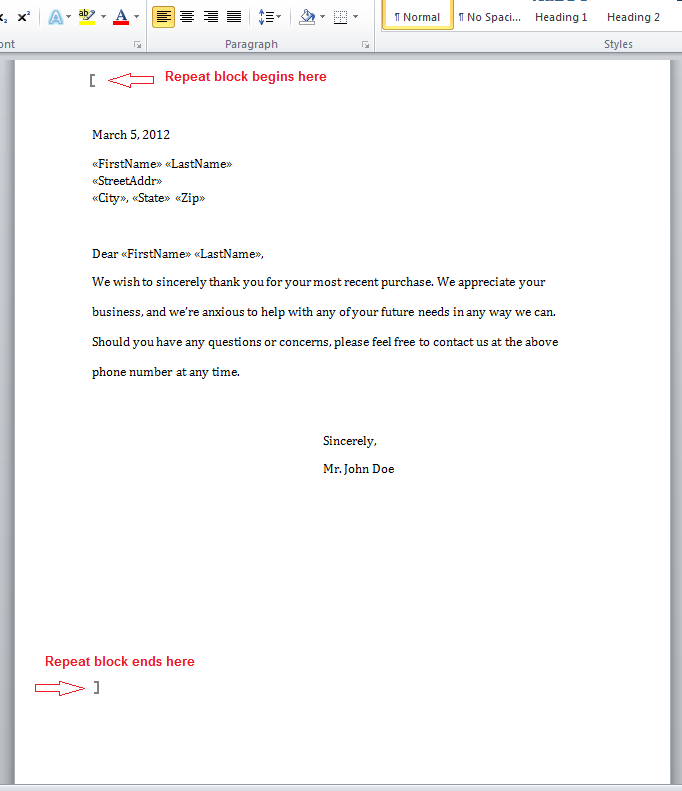| Wiki Markupexcerpt |
|---|
Use a *a repeat block * toto import multiple rows from a data source. A repeat block is a fragment in the template document - defined by a Word bookmark - that contains [contains merge fields|Creating a Template#mergefield] and that will be repeated for each row in a data source. To import multiple rows from a single data source, create a repeat block in the template and, in the WordWriter code, call SetRepeatBlock to bind the repeat block to a data source. The main document is any part of the template that is not within a repeat block. SetDataSource sets a *single-row* data source for merge fields in the main document. If you pass SetDataSource a ResultSet that contains more than one row, WordWriter will import the first row to the template. Multiple row data sources can be imported to repeat blocks only, not to main document merge fields. To create a repeat block: # In Microsoft Word, create a text fragment, a list, or a table row that contains [merge fields|Creating a Template#mergefield]. # Select the text, list, or table row that you want to define as a repeat block. # Open the *Insert* menu and select *Bookmark...* to open the Bookmark dialog. # Enter a bookmark name and click *Add*. In Microsoft Word, bookmarks are not marked by default. To see which document fragments are bookmarks: # Open the *Tools* menu and select *Options...* # Select the *View* tab. # Under *Show*, check *Bookmarks*. Bookmarks will be marked by grey brackets. Whether the template will bind to one data source or several, merge fields are not required in the main document. To import multiple rows from a single data source, use a repeat block only, and do not include any merge fields in the main document. The repeat block can span all the content in the document. For example, by defining a repeat block with a bookmark that spans an entire page, and setting a multiple-row data source, you can use WordWriter to create multiple form letters: !import_multiple_rows.png! Here is some example code that demonstrates the usage of SetRepeatBlock with a DataTable that has multiple rows. This code inserts data into merge fields "FirstName" and "LastName" enclosed in the repeat block named "BookMarkName". {csharp}fields and that will be repeated for each row in a data source. To import multiple rows from a single data source, create a repeat block in the template and, in the WordWriter code, call SetRepeatBlock to bind the repeat block to a data source. |
The main document is any part of the template that is not within a repeat block. SetDataSource sets a single-row data source for merge fields in the main document. If you pass SetDataSource a ResultSet that contains more than one row, WordWriter will import the first row to the template. Multiple row data sources can be imported to repeat blocks only, not to main document merge fields.
To create a repeat block:
- In Microsoft Word, create a text fragment, a list, or a table row that contains merge fields.
- Select the text, list, or table row that you want to define as a repeat block.
- Open the Insert menu and select Bookmark... to open the Bookmark dialog.
- Enter a bookmark name and click Add.
In Microsoft Word, bookmarks are not marked by default. To see which document fragments are bookmarks:
- Open the Tools menu and select Options...
- Select the View tab.
- Under Show, check Bookmarks. Bookmarks will be marked by grey brackets.
Whether the template will bind to one data source or several, merge fields are not required in the main document. To import multiple rows from a single data source, use a repeat block only, and do not include any merge fields in the main document. The repeat block can span all the content in the document. For example, by defining a repeat block with a bookmark that spans an entire page, and setting a multiple-row data source, you can use WordWriter to create multiple form letters:

Here is some example code that demonstrates the usage of SetRepeatBlock with a DataTable that has multiple rows. This code inserts data into merge fields "FirstName" and "LastName" enclosed in the repeat block named "BookMarkName".
| Csharp |
|---|
void GenerateDocument(int employeeID)
{
//--- Query the database
DataTable dt = new DataTable();
using(SqlConnection conn = new SqlConnection(connString))
{
string sql =
"SELECT FirstName, LastName FROM Employee";
SqlDataAdapter adpt = new SqlDataAdapter(sql, conn);
adpt.Fill(dt);
}
//--- Use a DataTable as the data source
WordTemplate wt = new WordTemplate();
wt.Open(templatePath);
wt.SetRepeatBlock(dt, "BookMarkName");
wt.Process();
wt.Save(Page.Response, "RepeatBlockOutput.doc", false);
}
{csharp}
{vbnet}
Private Sub |
| Vbnet |
|---|
Private Sub GenerateDocument(ByVal employeeID As Integer)
Query the database Dim dt As Newdatabase
conn)
'--- Use a DataTable as the data source Dim wt As Newsource
"BookMarkName")
"RepeatBlockOutput.doc", False)
Sub |
Code Sample:
...
...
Merge
...
using
...
Repeat
...
Blocks
...
The
...
following
...
code
...
sample
...
demonstrates
...
the
...
use
...
of
...
SetRepeatBlock
...
to
...
emulate
...
...
merge
...
behavior.
...
The
...
repeat
...
block
...
spans
...
an
...
entire
...
page
...
within
...
the
...
document.
...
This
...
causes
...
a
...
new
...
page
...
to
...
be
...
created
...
for
...
each
...
recipient
...
in
...
the
...
database:
...
[
...
C# |
...
...
]
...